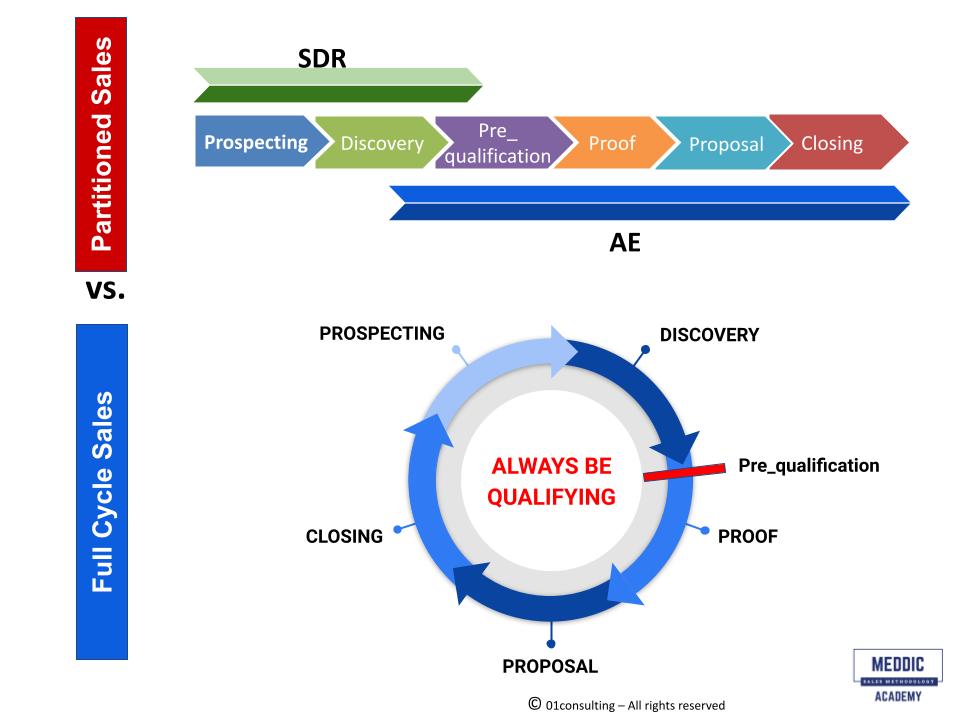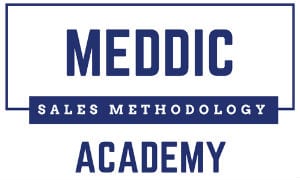In the early 2000s, within just a few years, we (tech sales people) somehow magically started switching from the full cycle sales models to the now over-popular SDR/AE model. Just like in any other social or business movement, such as fashion, politics or relationships, the majority follows a trend because of the attractive points in that trend, but ignores everything they lose by doing so. The trend is exaggerated. It takes time for the pendulum to return and find a balance. The move from the full sales cycle model to the SDR/AE is no exception; we wanted to reduce the CAC (customer acquisition cost) and thought we would improve specialized skills, but we lost in customer centricity, people centricity and didn’t always observe that promised profit. Many sales teams should now reconsider the model and maybe return to full cycle sale when justified.
We thought that by hiring junior, inexpensive SDRs who would qualify leads, we would save senior sellers’ time (and money) so that they can focus on nurturing and closing deals. What some of us were fast to point out is that sales don’t happen only at closing. They start happening at discovery, obviously continuing during qualification, during validation and of course while closing. Always what?… Be Qualifying, yes Always Be Qualifying. There is actually an extra cost when you let more junior people discover and pre-qualify, because they miss some opportunities that more senior AE would not miss. You got it, I don’t believe that the SDR/AE model is the right model for most companies. Let’s analyze the reasons.
SDR/AE Model Is Not Customer-Centric
Vendors and prospects build rapport through individual human beings from both sides interacting with each other. Sales happen when a momentum is created taking the prospect from a conversation around the PAIN POINTS towards the PROOF POINTS and METRICS, showing them your SOLUTION. You break this momentum in the middle of the sales process by handing off the prospect from SDR to AE. Customers have started to build rapport with the SDR when they have to introduce them to the AE. I don’t believe your customer-centricity stories if you don’t care about what your customer likes.
Customers like to speak to the most knowledgeable person possible from the very first call. If you care about your customers, put your most knowledgeable people, as soon as reasonably possible, in front of your customers. This is true also from the seller’s viewpoint. Why would you hide your most senior people from your prospects until the 2nd or 3rd contact? Wouldn’t you drastically increase interest in your business if you impress the clients with very knowledgeable customer-facing people?
In a full cycle sales model it’s much easier to build seller-champion relationships. As we know, No Champion No Deal. The key win-win connection between the seller and the champion is built from day one. These relationships, as we work on them at MEDDIC Academy workshops, start from the very beginning. Customers enjoy them. We help the champion in the account by feeding them with the right materials such as business cases and ROI. Sellers empower the champion by connecting him/her to the right people in our organization. We have more time and more opportunities to build champions in a full cycle sales model.
SDR/AE Model Is Not People-Centric
If we care about building interesting jobs for our talents and keeping them motivated, we should avoid the SDR/AE model. For many SDRs, calling and prospecting all day long is boring. I understand them. I for one may have never become an AE if I had to start as a SDR. Worse, the promotion from SDR to AE is totally irrational; it’s based on SDR’s performance which is about prospecting, for a job (AE) which has no or small prospection in it. In other words someone can be a great AE but wasting their time as a SDR, in some cases even getting demotivated and reorienting their career to something else. I have seen too many great AEs who would have failed as SDRs.
In a full sales cycle model, junior reps start with easier products and services, with shorter sales cycles, easier decision processes and smaller deal sizes. In extreme cases they may even start with retail sales and move to B2B after a few years. When they start their career right away in high-end complex B2B sales, which is absolutely possible as well, they shadow a more senior sales person and learn as they go. They will learn by doing. They are assigned smaller deals, or cheaper products.
By running the whole cycle, junior reps experience and taste the pleasure of closing deals at their first job. That’s how they fall in love with sales. As they acquire experience, they can move out of the shadow of a senior rep and become individual quota carriers. In their second or third year, they will become ready to sell more complex solutions, either at the same company or in another company. Some companies with short sales trainings can hire out of college. Some other companies will hire those with a few years of experience and that’s perfectly fine.
SDR/AE Model Is Not Even Profit-Centric
If your SDRs are more than appointment setters and actually pre-qualify deals (otherwise what’s the point if they don’t pre-qualify), then it means, by definition, that they disqualify some contacts or accounts. Are you sure there are not some great opportunities disqualified too soon, too fast? The more complex your solution, the higher the chance a junior SDR can’t start the discovery. I see this happening too often. Based on simplistic qualification criteria, such as lack of budget or the wrong timing, opportunities get disqualified, while they should not.
I also see it often as a buyer myself, when SDRs who are selling on me, are checking boxes. They often don’t realize that I don’t always disclose everything in the first call. I know that when your SDRs are well trained to MEDDPICC and MEDDIC, they know they should neither use BUDGET nor the TIMING as qualifiers, but too many people do so and BANT their prospect at the SDR level.
The experienced AE however, would be able to focus on pain points, quantify them and show them that the budget is found in the savings and that the timing was yesterday. More importantly, experienced AEs are able to catch hidden opportunities which were not initially expressed by the prospect. They have more knowledge of the customer stories that they can relate to a prospect’s pain point. This allows the prospect to feel understood, and helps create the TRUSTED ADVISOR connection. It’s key to building CHAMPIONS as well.
So we built this model mainly for profitability. On the surface we feel as our CAC has reduced since the SDRs OTE is significantly less than AEs. But we lost in sales efficiency and productivity. We achieve lower numbers. Year after year, the quota achievement has been slowly decreasing.
Alternative Model
First let me emphasize that sales processes should be built as the startup matures, based on trial error. So if you tried both models and figured SDR/AE model works for your company better than the full cycle model, then go for it. What you should NOT do is to take the SDR/AE model as THE ONLY SALES MODEL because a lot of companies do so.
Let me remind you how the model became popular. Unlike what many people think it’s not Aaron Ross’s Predictable Revenue (great book) which made it popular. It was already popular well before that book. I was personally exposed to it in early 2000 and many advanced tech companies started practicing it in the late 90s. That was when the “outsourcing” and “off-shore” phenomena were on the rise, mostly in engineering and manufacturing, but also in sales. The idea was to divide a process in stages and to get it done by cheaper labor. It was an attractive idea. In sales it got accentuated by some senior Account Executives and Account Managers who hate prospecting. They loved having someone else do what they disliked. Those same AEs came later to complain why they don’t have enough leads. Some sales people never have enough leads anyway, right?
Now this model is the only model known to some Gen X and all millennial and Gen Z sellers. They haven’t seen or experienced anything else. We need to help them open their eyes and their minds to alternative models which may work better for them and advance their career faster and are happier at their job.


Comments are closed.